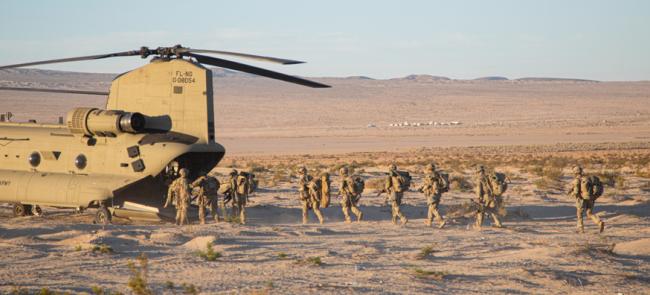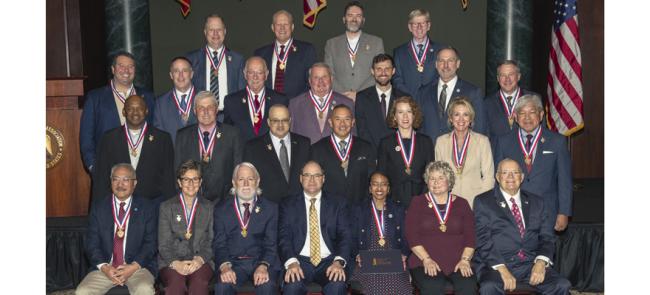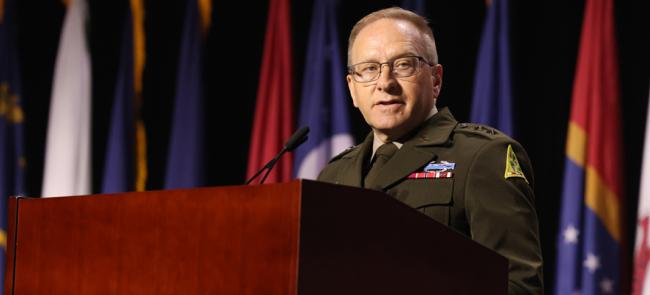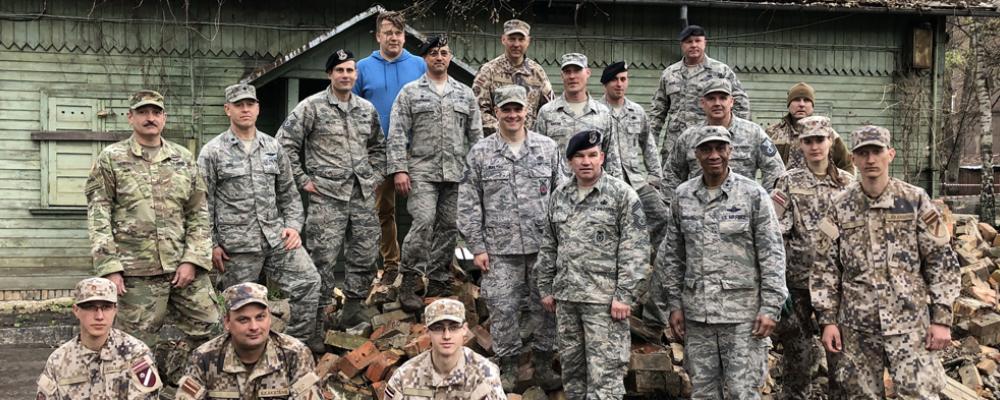
International Bonds
Latvia needed a tuba for its military band in 1992. And Lt. Gen. John B. Conaway, the chief of the National Guard Bureau, was determined to see that the newly independent country on the Baltic Sea got one.
It’s a quirky story that is part of how the Guard State Partnership Program got started, and how it became part of Conaway’s legacy during his final year atop NGB.
“Their military band was going to perform,” Conaway explains. “The Army Reserve gave us a brand-new tuba, and we took it over. They were playing that tuba during a ceremony that we attended at one of their cemeteries.”
The trip was in November 1992, a time of great upheaval in Eastern Europe. The Soviet Union and its Warsaw Pact military alliance had collapsed the year before. Several countries that were part of the USSR, or under its grip, were now free. Things were moving so fast that Russian troops had not yet pulled out. Conaway today recalls them filming his every move.
He also thought the Guard could do more than deliver a musical instrument. His visit, which had the Pentagon’s blessing, also included stops in Estonia and Lithuania, which are also on the Baltic Sea. The experience spawned the idea of partnering Guard states with the emerging democracies.
Conaway believed the Guard at the state level was uniquely suited to help show the former Soviet republics what freedom now made possible, starting with building Western-style militaries under civilian control.
“Potential partners saw how the National Guard operates, taking care of the local community in the state while also trained for the federal mission,” Conaway says. “We fit their template better than the active-duty military did, and that’s why they came to us.”
The Guard also had experience with international partnerships: The Minnesota Guard had a longstanding relationship with Norway and Puerto Rico led Guard exchanges in Central and South America.
Conaway’s idea proved popular on both sides of the Atlantic. “I had to fight them off,” Conaway says of the adjutants general of potential Guard partner states. “They were coming at me loaded. They all wanted in.”
In April 1993, NGB linked Michigan with Latvia, Maryland with Estonia and Pennsylvania with Lithuania. All three states had strong ethnic ties to their new Baltic partners. Michigan, in fact, had the nation’s largest population of Latvian Americans. But those unions were just the start. All told, 13 partnerships were formed that year with former Eastern Bloc countries. And the Guard did help show their partner nations what was possible.
Thirty years later, the SPP is global. All 50 states, Guam, Puerto Rico, the U.S. Virgin Islands and the District of Columbia have formed 88 partnerships with 100 countries — more than half the sovereign counties worldwide. States with two or three partnerships are common; Montana has four. The program could expand to 130 countries, but that would depend on, among other things, adequate funding.
Today, the SPP today is no longer singularly focused on emerging democracies, but building trust and forging enduring friendships with global partners has long been the goal. And Gen. Daniel R. Hokanson, the current NGB chief, says the current security environment makes it as important today as it was in 1993.
“Our National Defense Strategy is clear: Mutually beneficial alliances and partnerships are an enduring strength,” the 29th NGB chief says.
Three recently added African countries brought the membership to an even 100. NGB expects Gabon to be affiliated with one state and neighbors Zambia and Malawi with another very soon, officials say.
“It wasn’t some deliberate plan to get to 100 at 30 years. It’s just how things worked out,” says Maj. Gen. William Zana, NGB’s director of Strategic Plans and Policy and International Affairs, which overseas SPP.
The SPP celebrated its 30th birthday July 17-18 at the Gaylord National Resort and Convention Center in National Harbor, Maryland. Senior defense officials from more 90 SPP countries, combatant commanders and all 54 adjutants general attended. They shared information and heard from Pentagon leaders.
“We are stronger together than we will ever be by ourselves,” Gen. Mark A. Milley, the chairman of the Joint Chiefs of Staff, told the group. “When a crisis hits, you can surge people, but you can’t surge trust. You can surge equipment, but you can’t surge trust. You can surge all kinds of things, but you can’t surge trust. That trust is built over years.”
Trust is built through shared experiences that sometimes involve great hardships, Milley said.
“Because when you pick up a phone and call someone that … you have trust in — built up over the years — that will make the difference … between chaos and order, and sometimes the difference between war and peace,” he added. “We’ve seen the richness of these relationships develop through the State Partnership Program, and they play a very large role in world crisis.”
We've seen the richness of these relationships develop through the State Partnership Program, and they play a very large role in world crisis.
—Gen. Mark A. Milley, the chairman of the Joint Chiefs of Staff
NO ONE COULD HAVE PREDICTED what the SPP would amount to 30 years ago. Conaway credits the late Army Gen. John Shalikashvili, who was born in Poland, with giving it a chance as Supreme Allied Commander Europe.
“Peace was breaking out all over — in Europe and the United States,” remembers Conaway of the big picture soon after the Cold War ended with the Soviet Union’s collapse. “Everybody was saying the military’s going to get smaller and smaller. Our budgets are going to get smaller. We’ve got to make sure that we have a relevant mission in the National Guard.”
With Russian troops still across Eastern Europe, Shalikashvili intended to punctuate American interests with visits to former Eastern Bloc countries, Conaway says.
“I said why don’t you use the National Guard because I’m sure they’re going to want to start Home Guards” and the Guard could help them do so, Conaway recalls. “Shali jumped at that idea.” Defense Secretary Richard Cheney and Gen. Colin Powell, the chairman of the Joint Chiefs of Staff, liked it too, he adds.
“Shali said, ‘Conaway, you can do the first visit,’” Conaway says. “I contacted the Baltic-American Freedom Foundation. We set up a trip for 30 people — disaster and emergency services people, doctors, nurses and Guard officers — in [late] 1992.
“We went over there with supplies,” Conaway says, including Latvia’s tuba. Five months later, the SPP had its first three partnerships.
The SPP evolved from a 1991 U.S. European Command decision to set up the Joint Contact Team Program in the Baltic Region with reserve-component soldiers and airmen. But the Pentagon agreed with Conaway that directly pairing the newly independent countries with the Guard made the most sense.
First, the militaries in these countries had missions closely aligned with the Guard. They could be called to respond to natural disasters and humanitarian crises. Guard leaders are also not reassigned every three years to a different location. This would enable continuity, with state and partner military personnel able to bond personally over time.
Finally, low-level exercises, or “engagements,” involving citizen-soldiers were believed to be less threatening to Russia than large maneuvers involving tens of thousands of troops, such as Return of Forces to Germany, or REFORGER, during the Cold War.
All this doesn’t mean the Guard has stewarded the SPP alone. While administered by NGB and executed by the state adjutants general, the SPP is guided by State Department foreign policy goals in support of combatant commanders, and U.S. Chief of Mission security cooperation objectives and DoD policy goals.
Guard soldiers and airmen began traveling to the lands of their former enemies in 1993, finding no shortage of work. Russian troops had left those countries in shambles. In Estonia, for example, they stripped barracks to their dirt-streaked walls, according to accounts. What couldn’t be taken, like the rows of sinks and toilets in the bathrooms, they filled with cement.
But it didn’t take long for citizens across Eastern Europe to learn the newly arriving foreign troops were different. The Guardsmen came in smaller numbers and didn’t stay very long. They were there to help, not to occupy.
Guardsmen were producing tangible results within two years, according to a story in the May 1995 issue of National Guard. In Albania, which didn’t join the SPP until 2001, New Jersey Army Guard Col. Dave Bliss, a constitutional lawyer in civilian life, helped the nation draft a new constitution. Meanwhile, Hungary rewrote its uniform code of military justice using the U.S. code as a model. Lithuania and Poland began setting up an American-style professional noncommissioned officer corps. And Georgia the country, which is partnered with Georgia the state, was going even further, reforming its entire military.
Partner nation officials also came to the U.S., the same story said. Czech leaders visited Texas. Estonians watched the Maryland State Senate in action. Slovenian defense officials toured Colorado. Ukrainian officers were welcomes to Wilkes-Barre, Pennsylvania, with ethnic food and folk songs from elated Ukrainian Americans there.
Ten of the original 13 SPP countries joined NATO. Officials on both sides of the Atlantic say the alliance didn’t spread east as much as Eastern Europe, after decades of Russian domination, headed west.
Potential partners saw how the National Guard operates, taking care of the local community in the state while also trained for the federal mission.
—Lt. Gen. John B. Conaway (Ret.), National Guard Bureau chief (1990-1993)
MULTIPLE BUT MODEST MILITARY TRAINING engagements have been the foundation of SPP from the beginning. Those led to numerous partner-nation deployments to Iraq and Afghanistan. Some partner countries had only one condition before agreeing to go — that they went with Guard troops from their partner states.
They have also led to various civilian collaborations between educators, state and municipal leaders and businesspeople in the partner states and countries.
A few examples begin with California and Ukraine, one of the 13 original partnerships.
At first, it was a largely ceremonial affiliation so the American state and the former Eastern Bloc country could get to know one another. “You’re battling many years of perceptions. You’re making friends. You’re sharing things,” says Maj. Benjamin Paine, the California Guard’s SPP director, who has been with the program for more than eight years.
The relationship took a significant turn in 2014 when Russia annexed parts of eastern Ukraine and when Ukrainian people began looking to the West and serious contemplating NATO membership. “The Ukrainian people chose Euro-Atlantic integration,” Paine says. “The partnership went from ceremonial and relationship-building to assisting Ukraine in achieving NATO capability.”
It ramped up even more in February 2022 when Russian forces began trying to conquer the entire country — so far unsuccessfully.
“We went from supporting a NATO-capability target to identifying niche engagements to supporting the largest land war in Europe since World War II,” Paine continues. “It was an opportunity for us to learn from the Ukrainians. Because they’re the only ones fighting a large-scale combat operation right now. And what they’re gleaning from it would be of value to us, not only in assisting them, but should we find ourselves, unfortunately, in a major large-scale combat operation in the future.”
The key was identifying engagements that would add value to the Ukrainians and U.S. European Command that California could facilitate. “It’s not like we were sending bullets and bombs in the beginning. We weren’t,” Paine explains. “That’s not the role of the National Guard or state partnerships. But we were putting people in the right contacts.”
In May, behavioral health officers from Ukraine and the California Guard met in the southeastern Polish city of Rzeszów to discuss wounds of war that aren’t so immediately apparent as torn flesh and missing limbs.
Post-traumatic stress disorder, acute anxiety and acute stress reactions were among the lessons that the partners could share with one another, and which will be discussed again during future meetings, Paine says.
“We have had 20 years of experience with this in Iraq and Afghanistan. We learned things that they’re learning now. We’re hoping to pass on our tactics, techniques and procedures to them but to also learn from Ukraine,” he explains. “We’re really trying to understand how Ukraine is handling the volume of trauma.
“I think that kind of gets to how the partnership has matured.”
The U.S. Air Force on June 6 began leasing a C-130H transport to the Argentina air force through the Georgia Air Guard. Georgia and Argentina became SPP partners in 2016.
Argentina is leasing the aircraft for 11 months with an option to buy, reports the Georgia Guard. Aircrews from Georgia’s 165th Airlift Wing and Argentina flew together to the South American country for the delivery. Guard airmen were to remain in Argentina for 10 days to train five additional crews in the I Brigada at El Palomar Air Base.
The Georgia wing is replacing its older H model C-130s with newer J models, a spokesperson explains. But the H-model cargo plane is reportedly the youngest C-130 in the Argentine fleet by 21 years and could expand the fleet’s life expectancy for years to come.
The C-130H lease arrangement exemplifies “the National Guard, allies and partners working together to upgrade equipment, boost readiness and enhance mobility,” remarks Col. Scott Humphrey, NGB’s chief of International Affairs.
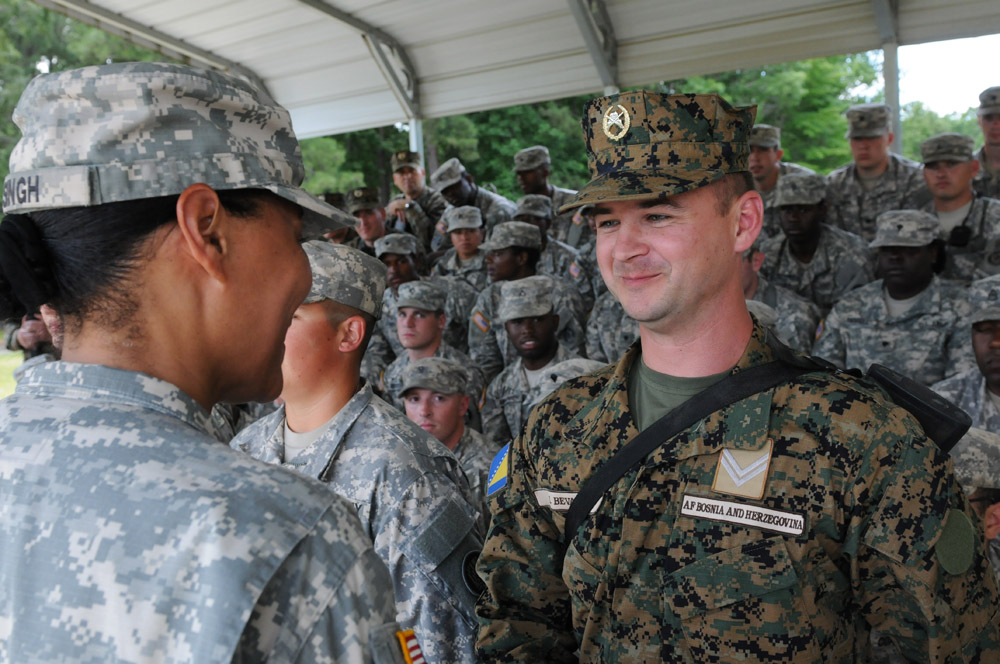
VERMONT HAS NOW PARTNERED with three nations after first affiliating with North Macedonia among the original 13. The other two are Senegal, in western Africa, in 2008 and Austria, in central Europe, last July. That Austrian partnership, however, was more or less a formality, explains Maj. Gene Enriquez, Vermont’s SPP director.
Vermont and Austria both have mountainous terrain and seasoned mountain soldiers. They have been training together in military mountaineering — mountain warfare — as far back as the 1980s, he says.
They also have experts in handling military munitions — in safety procedures, precautions and disposal. Those people are working with the Senegalese in a Physical Security Stockpile Program.
Senegal has several munitions storage sites in the country, Enriquez reports. Most of the ordnance is at one site in Dakar, the capital city. Senegal has recently received a munitions storage facility which has been placed in a small city outside of Dakar. “The plan is to oversee the transfer of munitions from densely populated Dakar to the new facility as the first step to make the capital more safe,” he adds.
“It’s a good example of shared values, looking for areas of shared opportunities and challenges,” Zana says. “I think the multilateral nature of the relationships is one of the most important things for the growth and the full evolution of the SPP.”
There is more going on than mutual military mentoring and training and, in Latvia’s case, a new tuba.
Michigan did, indeed, help Latvia build its defense forces including its national guard, the Zemessardze, from the ground up, says retired Brig. Gen. Robert V. Taylor, who got involved with the program as a colonel.
Michigan and Latvian troops have deployed together to Iraq and Afghanistan in blended units that Taylor calls “omelets,” a combination of soldiers in which, perhaps, the commander was from Michigan and the executive officer was Latvian.
The friendship matured to the point, Taylor says, where if the U.S. State Department wanted to deliver something to the Latvian president, it would give it to the Michigan Guard “because someone who was always over there would be able to hand deliver a document into the president’s hands.”
And Taylor recalls the time when he sat, in his Class A uniform, next to Latvia’s chief of defense, Raimonds Graube, and opposite staff members from the Senate Foreign Relations Committee during a meeting in Latvia. “I think that was the first time that group heard about the SPP,” he says.
Michigan also introduced the Latvians to Family Programs, “which the Soviet Union never had,” Taylor says. It was the American idea that “if your spouse isn’t happy with what’s going on, that vote sometimes is going to trump yours. You need to be cognizant of the fact that when you’re training, when you’re gone, your spouse is back home dealing with [family matters.]”
Latvian wives met Guard wives and attended family support conferences in Michigan. They talked about deployments and redeployments and other issues. “And they got it,” Taylor claims. “It had never occurred to them. It took them out of the Soviet mindset that they just didn’t care.”
They were informed about the importance of military chaplains should their soldiers become casualties and the roles of sergeants major and other NCOs.
“It meant a lot to them, and I think they’re reaping the benefits,” Taylor says.
The Latvians have not forgotten Taylor. Nineteen years after stepping down as assistant adjutant general of Michigan, Taylor received Latvia’s Medal of Merit by Minister of Defense Ināra Mūrniece at the Latvian Embassy in Washington, D.C., July 18. He was honored for “the significant contribution of development of Latvian Armed Forces.”
“We made friends for life,” Taylor adds.
We made friends for life.
—Brig. Gen. Robert V. Taylor (Ret.), formerly of the Michigan Army National Guard, who got involved with the program as a colonel.
THE MASSACHUSETTS GUARD is delivering civilian firefighting equipment, including two fully-equipped fire trucks, to its partner Paraguay’s military firefighters. Massachusetts began that South American partnership in 2001.
Capt. Christopher McCrobie, the Massachusetts SPP director, discovered that Paraguayan firefighters were sustaining heavy injuries from heat exposure, and were fighting fires in shorts and sandals, because they didn’t have fire-retardant helmets, jackets, pants, vests and gloves, according to NGB. McCrobie set about fixing that problem this year.
Local Massachusetts fire departments have contributed 1,000 sets of personal protective equipment that, after 10 years, no longer meets National Fire Protection Agency standards.
A KC-135R Stratotanker from the Maine Air Guard’s 101st Air Refueling Wing flew the first 500 sets to Paraguay on May 16. Massachusetts doesn’t have airlift capability. That underscores a point that leaders frequently make about how states can call on other states for SPP support. The rest of the equipment, including the trucks, is scheduled for delivery later this year.
A six-week conflict in 2020 between Armenia and Azerbaijan, both former Soviet countries, points to another way SPP might serve as a stabilizing influence. Armenia has been partnered with Kansas and Azerbaijan with Oklahoma since 2002.
Could such a conflict present a potential conflict of interest for the partner states? Not necessarily, maintains Zana. Perhaps they could calm troubled waters.
“We could have nations that have adversarial tensions, but we’re able to bring them together or have them participate in some of the same exercises,” Zana says. “We certainly seek those opportunities. I think one of the biggest things is having these relationships that go over the course of many years. We understand the nuances of some of those tensions and issues and often can help shape the Department of Defense’s and support the Department of State’s efforts when there are tensions.”
Far to the west of Paraguay, roughly halfway across the Pacific Ocean, the island nation of Samoa is anticipating guidance from Nevada about improving its police force and dealing with natural disasters. It does not have a military force.
The Polynesian island is among the most remote of the 100 partners. But it is not unique in that regard. It forms a fairly tight tropical triangle with Tonga and Fiji, which were partnered with Nevada in, respectively, 2014 and 2018.
They are among 16 partners within the U.S. Indo-Pacific Command and help explain how far beyond Eastern Europe and the Americas the SPP net has been cast. Nineteen partners are in the Africa Command.
Nevada’s three partnerships, according to Maj. Dustin Petersen, the Nevada SPP director, and Sgt. 1st Class Talia Whittle, the Hawaiian-born NCO in charge, also illustrate the diverse array of requests and expectations.
Tonga wanted help with administrative support for its mixed bag of army, marine, coast guard and navy personnel. Fiji requested assistance in developing an NCO corps for its Territorial Forces, which is essentially army. The program in Samoa is just getting started and will focus more on civilian police and emergency response techniques.
The Nevadans carefully avoid any impressions of knowing everything because they’re Americans. “It’s definitely a collaborative effort,” Petersen reports. “We conducted a major analysis on both Fiji and Tonga until we identified what our partners actually wanted instead of just going down there and saying this is what we’d like to do.”
Florida Lt. Col. J. Roland DeVries is SPP’s deputy senior Guard advisor to the Indo-Pacific Command where strategic concerns include climate change and unregulated fishing.
“The attitude as a whole is that SPP is definitely a valued tool in the security cooperation toolbox,” he says. “When you think about the professional and personal relationships that are developed over decades, the same people interacting as they have progressed through their careers, the same organization coming all the time, you don’t find that in any other security cooperation entity. That is worth its weight in gold.”
Bob Haskell is a retired Maine Army National Guard master sergeant and a freelance journalist in Falmouth, Mass. He may be contacted at [email protected].
TOP PHOTO: Michigan Guardsmen and members of the Latvian Zemessardze (National Guard) participate in a work project at the National Social Care Center in Riga, Latvia, as part of National Clean-up Day in 2018. (Photo by 1st Lt. Andrew Layton)
SPP’s Big Challenge? Finding Enough Funds
The state partnership program has long earned high praise from combatant commanders and Pentagon officials. Many have said the SPP is critical to global security cooperation. But all that acclaim isn’t translating into what is the life’s blood of any program — steady funding.
The current $40 million annual SPP budget, “plus the overhead of keeping the lights on,” amounts to a little under $400,000 a year for each of the 100 partnerships. Most of them have eight to 10 engagements each year [in the U.S. or in the partner countries,] says Col. Scott Humphrey, NGB’s chief of International Affairs.
“That money doesn’t go a long way,” Humphrey adds. “You have to be very judicious in how you do that.”
More than half of that amount comes from “congressional adds [to presidential budget requests],” says Maj. Gen. William Zana, NGB’s director of Strategic Plans and Policy and International Affairs, which oversees the SPP. “We’ve benefited from them and are grateful for the adds that have really sustained the program.”
The total is less than 1% of the nation’s security cooperation budget of roughly some $6 billion a year, Humphrey told the American Security Project during a June 20 webinar. “Of that, the SPP does 20% to 30% of all engagements for security cooperation worldwide. It’ almost 50% if you’re looking at Southern Command or Africa Command.”
It helps the bottom line if Guard troops can perform SPP missions during their two-week annual training. “That saves us a little on the pay and allowance side, but then they end up traveling on money from the budget,” Humphrey says.
States contribute to their programs in many ways. “Lucky for us, our adjutant general is so supportive of it, and our state is very much behind it, so we can pull off some really unique stuff,” says Maj. Dustin Petersen, the Nevada Guard SPP director.
“It’s a constant game of what I like to call ‘mathemagic,’” he adds. “It’s just trying to find different and unique ways to support these missions.”
The combatant commands can help at times. If activities have a high enough priority, the U.S. Indo-Pacific Command can help with transportation, equipment or personnel, says Lt. Col. J. Roland DeVries, the SPP deputy senior Guard advisor to the command.
But year to year, Zana says, “there are multiple challenges in how we go about funding this important program because we’ve expanded the number of partnerships. During this year, we’re going to have literally hundreds of unfunded requirements. There are missions that are validated by the combatant commands and that our states are able to support, but we just don’t have the funding to do.”
— By Bob Haskell
The Original 13 Partnerships
Bulgaria & Tennessee
Czech Republic & Texas/Nebraska
Estonia & Maryland
Hungary & Ohio
Kazakhstan & Arizona
Latvia & Michigan
Lithuania & Pennsylvania
North Macedonia & Vermont
Poland & Illinois
Romania & Alabama
Slovakia & Indiana
Slovenia & Colorado
Ukraine & California

